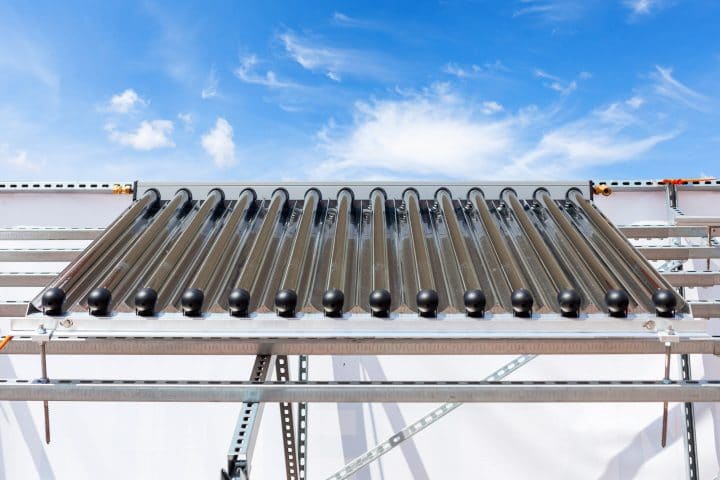Solar energy is one of the main types of renewable energy sources. It helps to support life on earth by warming our planet and feeding our crops. We can also use it to generate power and for heating water or air. But what is active solar energy?
The term ‘active solar energy’ often arises when discussing solar thermal heating systems. You may also hear the term ‘passive solar energy’ which is the opposite of active solar.
So, what does the ‘active’ part actually mean? Well, this refers to the type of system that is used. Any solar thermal installation that makes use of moving parts, electronics, switches, and/or controls should be considered an active system. This means that the vast majority of solar hot water systems can be classed as active solar energy because they often contain pumps, switches, and electronic controls.
How Does Active Solar Energy Work?
Active solar energy systems use solar energy to heat either a liquid or a fluid. They do this using what’s known as a solar collector which absorbs solar energy. During this process, heat is captured from the sun’s rays and is transferred to either fluid or air inside the collector.

Where a fluid is heated, this can next be fed into a heat exchanger, allowing it to transfer its heat to water. This water can then be fed into a building’s hot water supply or central heating system. These systems may also store the hot water in a storage tank for later use.
Other Uses of Active Solar Energy
We’ve already established that active solar heating systems can provide hot water for your taps and radiators. They can, however, be used in a couple of other ways as detailed below.
Heating Air
Yes, it’s even possible to heat the air inside your home from solar energy. In this scenario, air collectors are used instead of fluid collectors. There are two main types of solar air heating systems in use today:
- Closed-loop Systems – These systems recycle cooler air from inside your home by passing it through a solar air collector, heating the air, and then blowing it back into your home.
- Open-loop Systems – These are less common and work in much the same way as closed-loop systems, only they receive air from outside, heat it and then blow it into your home. This can be less effective than a closed-loop system as it has to do more work.
The major drawback of solar air heating systems is that they use a pump or a fan to circulate the air. This process uses electricity which may not come from renewable sources. Some homes are however fitted with solar panels to provide the electricity.
Heating Swimming Pools
Some swimming pools are fitted with a solar heating system. In such systems, an intake draws water from the pool and passes it through a solar collector where it is heated. The warmer water is then fed back into the pool, increasing its temperature.
As with most solar thermal energy systems, this process does, of course, involve a pump for moving the water. This needs to be powered and can use large amounts of electricity over time. You can, however, make use of solar power to reduce the impact this may have on your carbon footprint.
Solar pool coverings can also be installed to help absorb solar energy. These aren’t, however, examples of active solar energy systems. Instead, they are a type of passive solar energy. These covers also offer the added benefit of heat retention, reducing the rate at which the water loses its heat.
How Effective is Active Solar Technology?
Active solar technologies are much more effective than passive solar alternatives. Because they can move either fluids and air, they are more efficient and don’t simply rely on the natural absorption and spread of solar energy.
The cost-effectiveness of active solar energy systems depends on a range of factors. These can include where you live, the size of your house and the type and capacity of your system.
Most homeowners choose to install solar PV over solar thermal systems but this doesn’t mean solar thermal isn’t right for you. If you’re confused about the two, we also have an article covering the differences between solar PV and solar thermal.
Recap
So, we have learned that active solar energy refers to any system that makes use of moving parts, electronics, switches, or other controls. This is different from passive solar energy in that active systems have to do something to make use of the energy. Passive systems simply absorb solar radiation and don’t feature any ‘active’ or moving heat transfer systems.